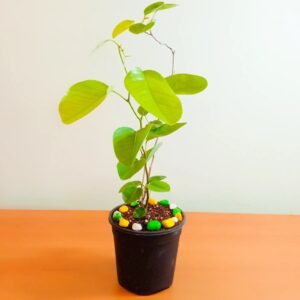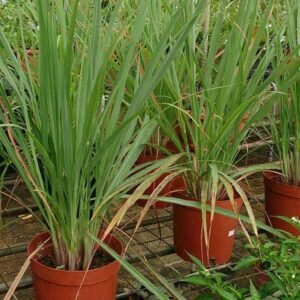Description
Jatropha Plant – A Comprehensive Overview
Introduction
The Jatropha plant, scientifically known as Jatropha curcas, is a hardy, drought-resistant perennial shrub or small tree belonging to the family Euphorbiaceae. Native to Central America, it is now widely cultivated in tropical and subtropical regions across Africa, Asia, and South America. Renowned for its potential as a biofuel crop, Jatropha has garnered attention for its ecological, economic, and industrial significance.
Botanical Characteristics
- Scientific Name: Jatropha curcas
- Common Names: Physic nut, Purging nut, Ratanjyot
- Family: Euphorbiaceae
- Growth Habit: Deciduous, woody shrub or small tree
- Height: Typically grows between 3–6 meters (10–20 feet)
- Leaves: Broad, green, three- to five-lobed with a soft texture
- Flowers: Small, greenish-yellow; both male and female flowers grow on the same plant (monoecious)
- Fruits: Ovoid, three-lobed capsules, each containing three black, oil-rich seeds
- Lifespan: Can live and produce seeds for up to 40–50 years under optimal conditions
Ecological Adaptability
Jatropha is highly adaptable to diverse climatic and soil conditions. It thrives in:
- Dryland ecosystems and semi-arid zones
- Poor, gravelly, or sandy soils
- Areas with rainfall between 300–1,000 mm per year
- Temperatures ranging from 20°C to 50°C
This resilience makes Jatropha a prime candidate for afforestation, soil erosion control, and rehabilitation of degraded lands.
Cultivation and Agronomy
- Propagation: Primarily by seeds and cuttings. Cuttings ensure genetic uniformity.
- Planting Density: Common spacing is 2m × 2m, allowing about 2,500 plants per hectare.
- Maintenance: Minimal irrigation and fertilization; pruning encourages branching and fruit production.
- Harvesting: Begins in 2–3 years, with peak productivity around 4–5 years.
- Yield: 1,500–2,000 kg of seeds per hectare annually under average conditions, higher with proper management.
Economic and Industrial Uses
1. Biofuel Production
The primary industrial value of Jatropha lies in its oil-rich seeds, which contain 30–40% oil suitable for conversion into biodiesel through transesterification. Jatropha biodiesel:
- Is renewable and biodegradable
- Emits fewer greenhouse gases compared to fossil fuels
- Can be used in standard diesel engines with little or no modification
This potential positions Jatropha as a sustainable energy crop, especially for regions aiming to reduce dependence on petroleum imports.
2. Medicinal Uses
Traditionally, various parts of the plant have been used in folk medicine:
- Leaves: Applied to wounds and inflamed areas
- Sap: Antiseptic, used for healing cuts
- Seeds: Used as a purgative (though toxic in raw form)
- Roots: Treat rheumatism and gastrointestinal issues
Caution is essential, as the plant contains toxins such as phorbol esters that can cause severe poisoning if ingested without proper preparation.
3. Industrial Applications
Jatropha oil and by-products are used in:
- Soap making
- Candles
- Varnishes and paints
- Organic fertilizers (seed cake after oil extraction)
- Biopesticides due to its pesticidal properties
4. Environmental Benefits
- Carbon sequestration: Helps absorb CO₂
- Soil improvement: Organic matter from leaf fall and composted seed cake
- Barrier plantation: Acts as a natural fence and windbreaker
- Waste land reclamation: Enhances biodiversity and prevents desertification
Advantages of Jatropha Cultivation
- Non-edible oil crop: Does not compete directly with food crops
- Low input requirements: Suitable for poor farmers and marginal lands
- Employment generation: Nursery raising, harvesting, oil extraction
- Multiple revenue streams: Seeds, oil, cake, biomass
Challenges and Limitations
Despite its promise, large-scale cultivation of Jatropha has faced numerous setbacks:
- Variable Yields
Yields are inconsistent and often lower than projected due to factors like poor soil, inadequate rainfall, or genetic variation. - Toxicity
Most varieties are toxic, limiting use of by-products like seed cake in animal feed. - Pest and Disease Susceptibility
While hardy, Jatropha can suffer from pests such as stem borers, aphids, and fungal infections under certain conditions. - Economic Viability
Without assured buyback policies, proper processing infrastructure, and stable fuel markets, farmers face uncertainty in returns. - Genetic Improvement
Lack of high-yielding, uniform cultivars hampers commercial success. Research is ongoing to develop better hybrids. - Policy and Infrastructure
Many government-backed Jatropha programs failed due to poor planning, lack of farmer education, and inadequate supply chains.
Recent Developments and Future Prospects
- Genetic Engineering: Efforts are underway to develop non-toxic and high-yielding varieties suitable for feed and fuel.
- Agroforestry Systems: Intercropping Jatropha with other crops can improve land use efficiency.
- Carbon Credits: Farmers and companies growing Jatropha may benefit from carbon trading schemes.
- Sustainable Aviation Fuel (SAF): Jatropha oil is being tested as a feedstock for aviation biofuels.
- Private Sector Engagement: Renewed interest from energy companies in diversifying feedstock portfolios has put Jatropha back on the map.
Conclusion
The Jatropha plant stands at the intersection of agriculture, energy, and environmental conservation. Its potential as a sustainable biofuel source is particularly relevant in the context of climate change and energy security. However, realizing this potential requires continued research, policy support, and holistic value chain development. If properly harnessed, Jatropha can contribute significantly to green energy transitions, rural development, and ecological restoration.





 Peace Lily, Spathiphyllum - Plant
Peace Lily, Spathiphyllum - Plant 

Reviews
There are no reviews yet.